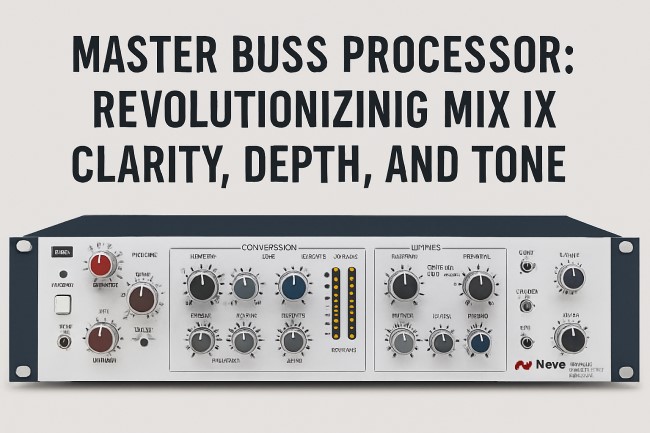Master Buss Processor: Revolutionizing Audio Dynamics and Clarity

Master buss processor is a term that carries significant weight in the world of audio production. Whether in a high-end mastering studio or a small home setup, this device can drastically impact the final sound of a mix. It is more than just a compressor—it’s a powerful tool that shapes tone, dynamics, stereo image, and sonic depth.
In this guide, we explore what makes the master buss processor so essential, how it compares to traditional gear, and why many professionals swear by units like the Neve Master Buss Processor and the Neve Portico II Master Buss Processor. We’ll also offer insights into selecting the best master buss processor for your studio needs.
What Is a Master Buss Processor?
A master buss processor is an audio device placed on the stereo output or mix bus. It typically includes multiple processing tools such as compression, limiting, mid/side stereo control, saturation, and sometimes equalization. The main goal is to enhance cohesion and control dynamics without sacrificing musicality.
Unlike single-channel processors used on vocals or instruments, this processor affects the whole mix. It’s the final polish before the track is released to streaming platforms, radio, or vinyl.
Traditional Compression vs. Modern Buss Processing
Early Compression Techniques
In the early days of analog mixing, engineers used stereo compressors like the SSL G-series or VCA-based units to apply gentle compression to the full mix. These processors added what many called “glue,” making individual elements feel unified. However, these older designs had limited flexibility.
Evolved Processing Tools
Modern processors do much more. Today’s master buss processors are sophisticated machines offering flexibility for multiple sonic goals: controlling peaks, widening stereo image, enhancing transients, or adding harmonic character.
The transition from traditional compressors to innovative master processors has given engineers greater creative freedom while maintaining technical precision.
Neve Master Buss Processor: Engineering Excellence
The Neve Master Buss Processor is a premium example of what this category can achieve. Crafted by Rupert Neve Designs, it offers musical compression, pristine signal paths, and high-voltage discrete Class-A circuitry. These features translate into superior sound quality and dynamic control.
This unit excels at both subtle and aggressive processing. With selectable compression types and parallel blend options, the Neve unit can handle a soft acoustic mix or a hard-hitting hip-hop beat with equal finesse. Its flexibility is what makes it a favorite among top engineers worldwide.
Inside the Neve Portico II Master Buss Processor
The Neve Portico II Master Buss Processor is often regarded as one of the best in its class. It blends classic Neve analog tone with modern engineering advancements.
Key Features:
-
Dual Compression Modes: Choose between feed-forward for fast, accurate control, or feedback for a more vintage, smooth response.
-
RMS and Peak Detection: Adjust how the compressor reacts to transients and sustained levels.
-
Blend Knob: Apply parallel compression without needing external routing.
-
Stereo Field Editor: Mid/Side controls allow manipulation of the stereo image with surgical precision.
-
Silk Texture Controls: Unique to Neve, these add harmonic color and depth with selectable Red and Blue tonalities.
-
Built-in Limiter: Transparent limiting helps achieve competitive loudness without distortion.
The Portico II is a hybrid of science and art, engineered for mastering engineers and mixing professionals who demand tonal control and character without compromising clarity.
Benefits of Using a Master Buss Processor
1. Glue and Cohesion
It binds elements of a mix together so that nothing feels separate or disjointed. Instruments and vocals begin to sound like they belong in the same space.
2. Dynamic Control
Instead of reacting to individual tracks, the processor works holistically. It manages peak levels and overall loudness, offering consistency throughout the track.
3. Tonal Enhancement
With harmonic features like Neve’s Silk modes, you can enrich the tone with subtle analog color that digital tools rarely replicate accurately.
4. Stereo Image Shaping
Using Mid/Side techniques, engineers can make the sides wider, the center tighter, or even isolate certain spatial aspects of a mix.
5. Loudness Optimization
Modern limiters in master processors allow music to be competitively loud while retaining punch and life—essential for streaming platforms.
How to Choose the Best Master Buss Processor
Know Your Genre
Electronic producers may need fast, aggressive compression. Jazz or orchestral engineers might prefer transparent processing. Choose a model that suits your musical style.
Feature Set
Look for units offering flexibility: attack and release control, sidechain filtering, M/S processing, and harmonic enhancement.
Build Quality
A master processor is a long-term investment. Brands like Neve are built for durability and consistent performance in high-pressure environments.
Workflow Compatibility
Ensure the device integrates easily with your setup—whether it’s analog, digital, or a hybrid. Consider latency, routing options, and recallability.
Software Alternatives vs. Hardware Units
Some engineers argue that modern plugins replicate analog gear well. While this is true to a degree, especially for budget-conscious producers, there are things hardware still does better.
The tactile nature, analog circuitry, and unique transformer behaviors of hardware like the Neve Portico II Master Buss Processor provide depth and realism hard to capture in digital emulation.
If budget allows, a high-end hardware unit will always offer a level of sonic integrity unmatched by software.
Related Units Worth Exploring
While Neve dominates this space, other contenders include:
-
Manley Variable Mu – Known for its warm, tube-driven character.
-
API 2500+ – Offers punch and forwardness ideal for rock and pop.
-
Shadow Hills Mastering Compressor – A dual-stage compressor with a large tonal palette.
-
SSL Fusion – A modern unit with saturation, stereo width, and EQ for tone shaping.
Each has a different personality. Testing them in your chain, if possible, is the best way to determine the right fit.
Final Thoughts
A well-chosen master buss processor can be the defining factor between a good mix and a great one. Tools like the Neve Master Buss Processor and the highly regarded Neve Portico II Master Buss Processor are more than equipment—they’re instruments that empower engineers to elevate sound with precision, character, and emotion.
Whether you’re producing pop, film scores, EDM, or classical recordings, the right processing unit gives you full control over the final touch—polishing the sound until it gleams with clarity and power. Choosing the best master buss processor means selecting a tool that fits your artistic vision and technical demands.



